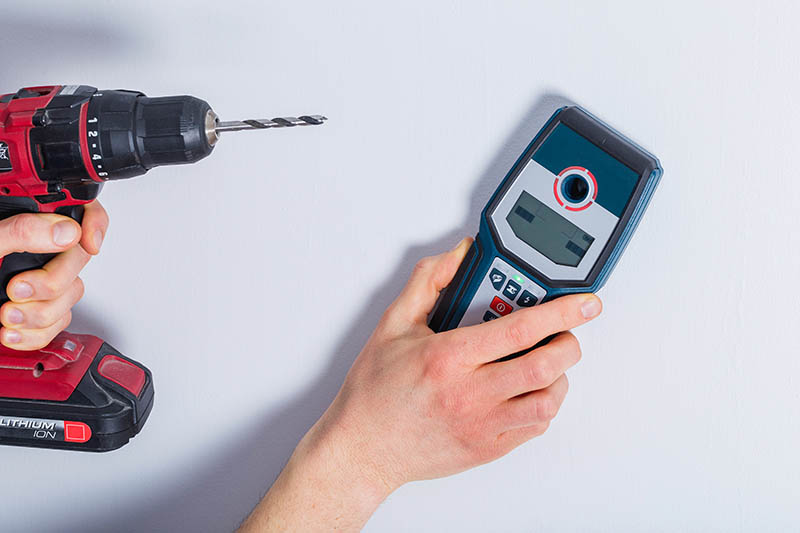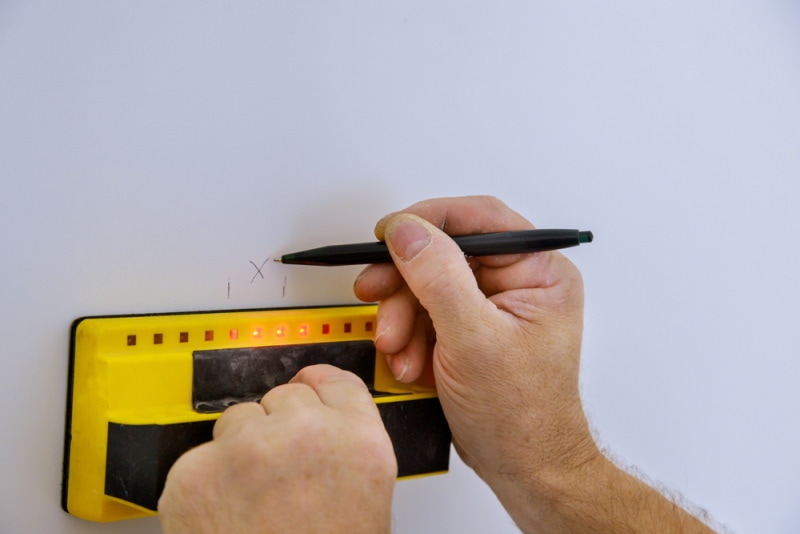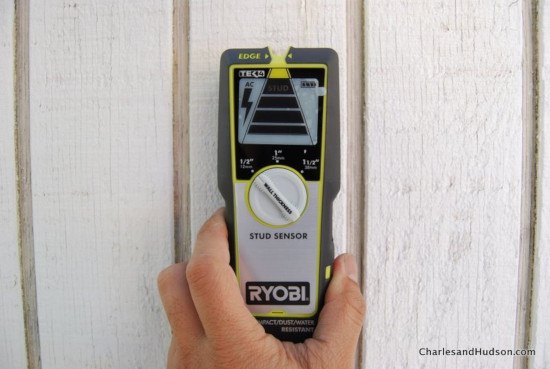How Does a Stud Finder Work? What You Need to Know
-
Pete Ortiz
- Last updated:

Back in the day, construction workers used to knock on walls with a hammer/screwdriver handle to locate the studs. That took a lot of time and effort. Today, they mostly use stud finders. Specifically designed for a single task—locating framing studs hiding behind drywall—these handheld devices are well worth the investment. This is true if you do construction work or like to remodel/decorate the walls.
Easy to use, lightweight, and efficient, stud finders come at a reasonable price. But how does such a device work? Are there different types of stud finders? Which device will be a better pick? You’ll find all the answers right here! First, we’ll talk about the definition of a stud finder. Next, we’ll cover the available options, common uses, and pros and cons.
How Does It Work?
Just like the name suggests, a stud finder is a device that helps find the framing studs, also known as the wall plates or lintels. In construction, the term “framing” is used to describe the skeleton of the house. Without it, the building will have no structure or support, nor will it be resistant to floods, hurricanes, heavy winds, or impacts. But what is the frame made of? The most common materials are wood (both natural and engineered) and structural steel.
And the job of the stud sensor is to detect the studs: vertical parts of the frame that hold it all together. Now, we can’t see the studs because the framing is covered by the finish: drywall panels, plaster, wood boards, or paneling. That’s where stud finders come in. They can either hone in on the metallic parts of the frame (like a nail or a screw) or scan the density of the wall. This way, it’s much easier to do a renovation or drive nails and screws into the walls.
What Are the Different Types of Stud Finders?
If you go shopping for a stud sensor, you’ll see that there are different types available on the market. The two main categories are magnetic and electronic stud finders. Plus, there are variations of both devices. So, what about the advantages and disadvantages to keep in mind? Here’s a detailed breakdown:
Magnetic Stud Detectors
Magnets and metal attract each other: that’s exactly how magnetic stud detectors work. As you move the device over the wall, the attraction gets weaker or stronger depending on how close you are to the metallic fasteners (like nails and screws) inside of the studs. Thus, if you feel like it’s getting harder to move the stud sensor around because it’s “sticking” to the wall, that means you’re really close. These devices are cheap, battery-free, and reliable.
Plus, they come with markers that you can stick to the wall. That makes it easier to find the studs. Magnetic finders don’t work on plaster or lath, though. Furthermore, they don’t find the studs but rather the metal, and sometimes, you’ll run into metal pipes or plates. Magnetic stud detectors do a decent job when dealing with surface fasteners but do require multiple sweeps to detect the metal.
- These stud finders are equipped with relatively small magnets; therefore, you’ll have to be hovering right above the stud to detect it. Moving the device along the wall until you come across a stud can be time-consuming. Besides, the deeper the fasteners, the less effective the stationary magnets will be.
- Moving stud sensors use rare earth magnets instead. They are more accurate and can detect metal in a wider area. For a project with thicker-than-average walls, portable stud detectors are highly effective. They don’t rely on the user to feel the attraction, yet when you get close to a metal nail/screw, the device will make a sound.
Electronic Stud Finders
The concept here is entirely different. Instead of using a magnet, electronic stud finders generate a magnetic field. That field determines the density (or, rather, dielectric constant) of the wall and sends a signal (like a beep or a LED light coming on) whenever it detects changes (like going from a hollow drywall to a stud). The biggest pro of electronic stud detectors over magnetic ones is that they are capable of locating the actual studs, not the nails or screws.
On top of that, they are much better (and faster) at finding the studs. You won’t have to draw any zigzags over the walls, either. Go over large parts of the drywall horizontally, and the device will let you know when a stud is found. A premium-quality electronic stud sensor can detect them up to 11 inches into the wall.
- Edge Finder: As you’ve probably guessed, these stud sensors signal the user when they locate either side/edge of the stud. Edge finders aren’t very efficient. You will have to calibrate the device first, move slowly, mark both edges, and only then find the center of the stud. And occasionally, you will have to deal with false positives. Electronic edge sensors cost $10–20.
- Center Finder: Also known as whole-stud detectors, center finders have two sensors instead of one and generate a series of magnetic fields for a more accurate reading of the wall. Again, the device has to be calibrated, and you’ll only need to go from left to right or vice versa. Center stud finders will set you back $20–30. The more expensive models can detect AC wires.
- Instant Stud Finder: This is the most expensive option on the table. Instant finders have even more sensors and locate studs almost instantly (hence the name). These devices do a great job of detecting not only the center of the stud but also the left and right edges, the hollow areas, and the thickness/width of the stud.
Where Is It Used?

There aren’t that many applications for a stud finder. Essentially, it’s designed and built for one single purpose: locating the stud within the frame. And it’s one of the least expensive tools in a construction worker’s arsenal. Home builders use it to locate pipes, wires, and, of course, parts of the frame. When they don’t know where the studs are, contractors can’t be very effective or efficient at remodeling a house.
Regular folks, in turn, use these devices to find the best spots around the house for hooks, holders, pictures, kitchen cabinets—you name it. Now, drywall is very bad at holding nails or screws. It’s very fragile, and you’ll probably end up ruining the wall. But with a stud sensor, you’ll know exactly where the studs are. The frame is much sturdier and will be able to handle both the nail/screw and the extra weight.
Advantages of Stud Finders
- Precise and highly efficient: Modern-day stud finders are very fast and accurate. You won’t have to wait long before they locate the studs. This is especially true if you pay a bit extra and get an electronic stud finder. Place it on the wall, activate the device, and it will reveal every single framing stud in the vicinity in the blink of an eye.
- Lightweight, easy to carry around: Stud detectors are handheld devices. That means they’re also compact, portable, and don’t weigh a ton. You can put it in your toolbox or even a big enough pocket and take it to the construction site. Most stud finders weigh 0.2–0.8 pounds and can be as compact as 5 x 3 x 1.5 inches or even smaller.
- Come at an affordable price: It’s safe to say that stud sensors are an affordable purchase. Right now, the market is overcrowded with decent-quality devices that will only cost you $15–25. And if you want a more advanced gadget, be ready to pay $40–60. A quick note: some brands pack their finders with battery sets to sweeten the deal.
- Multi-scanners can find wires: On top of finding the studs, multi-scanners are often used to detect unshielded wires hidden 1–2 inches within the walls. That helps avoid potential accidents. Along with that, multi-scanner stud finders can automatically correct calibration errors and “sense” studs located deep inside the wall.
Disadvantages of Stud Finders
- Electric finders need batteries to work: It’s not a huge downside, but can still be a con if you’re working on a large-scale project and don’t have any spare batteries around. Batteries don’t cost much, though, and only take two seconds to replace. Or, just use a magnetic stud sensor instead (although it won’t be as precise as its electric sibling).
- Rather brittle, easy to break: Like most devices that cost $15–60, stud finders aren’t very sturdy. When treated with care, they do last for a very long time. But, if you accidentally drop them on the floor, most likely, a repair will be in order. Look for a metal stud finder that’s water- and shock-resistant for extra durability and longevity.
- Magnetic finders are a bit slow: The biggest pros of magnetic stud sensors include an affordable price, reliability, and self-sustainability: no batteries are required. However, they also tend to be slow. You’ll have to go over the same area multiple times before the device detects a stud (or, rather, the metal fasteners).
 Frequently Asked Questions on Stud Finders
Frequently Asked Questions on Stud Finders
How Do You Use a Stud Finder?
First, put it against a wall and activate it. The finder will light up. Move it slowly to either side (horizontally) until you come across a stud. Remember: in the US, most studs sit 16 inches away from each other. And you’ll always find them in the corners and alongside entrance doors and windows. If you’re using an electronic center stud finder, once the gadget lights up, keep moving until the finder gets a full scan of the stud’s density and width.
With an edge finder, use adhesive tape or a pencil to mark the first edge. Now make sure you’re at least six inches away from the stud and reactivate the device. When you find the second edge, the sensor will beep once again: mark the new edge. With a magnetic stud detector, use S-shape sweeping moves instead. And when the locker sticks to the wall, mark that spot with a marker; do this 2–3 times for accuracy. You’ll find the center of the stud right in the middle of the markers.
Stud Finders for Phones: Do They Really Work?
There are lots of stud detectors out there that are designed to be used with a Smartphone. When you purchase such a device, you get a sensor plus a cord to connect it to the phone. So, how does it work? The process is rather simple: you move the scanner slowly over the drywall (or any other type of wall) and when a stud is detected, you will see a picture of it on the phone’s screen. Compared to full-fledged stud sensors, these gadgets aren’t nearly as accurate.
As for downloadable stud finder apps, they’re even less effective. Besides, if you download such an application from a “shady” website, chances are, it will be packed with adware or something worse. If you still want to use a stud finder app, look for it on the App Store or Google Store. This way, the chances of getting the phone infected will be minimal.
Are Radar Scanners More Efficient Than Stud Finders?
The short answer is yes, they are. This is a relatively new technology that succeeds not only in finding studs but also in identifying the wall type and the materials used in building it. They are great at locating wires, metal objects, leaks in the pipes, and even motion behind the walls (like pests, critters, or rodents). On the downside, radar scanners are a lot more expensive.
- You’re a pro-construction worker
- You want to manually build a house
- There are many wires/pipes in the walls
- Hanging pictures/shelves is your passion
- You don’t do much work with a hammer
- You prefer to hire pros for remodeling
- The budget for the project is limited
- You’re using a stud finder mobile app
In Conclusion
Stud finders have been around for many years, helping construction workers get the job done faster and more efficiently. For the most part, they can only do one thing—detect the studs behind the wall. The more expensive devices find wires and pipes as well. In any case, stud sensors are a great device to have in the toolbox.
To find the studs, all you have to do is press a button, and the device will do the rest. For someone who works with wood frames and drywall and values speed and precision, a stud finder is a lifesaver. That said, if you’re not a professional builder, you won’t have much need for it unless you’re a fan of decorating walls.
- How to Use a Stud Finder
- Wood Stud Wall Framing Details
- What Is A Wall Stud?
- Technology – Do Stud Finder Apps Work?
- PH&G.Com – What Are Interior Walls Made Of?
- Magnetic vs Electronic Stud Finders
- Magnetic vs. Electronic Models
- App for iOS and Android
- How To Use A Stud Finder
- What Is A Dielectric Constant?
Featured Image Credit: Cegli, Shutterstock
Contents




 Frequently Asked Questions on Stud Finders
Frequently Asked Questions on Stud Finders
